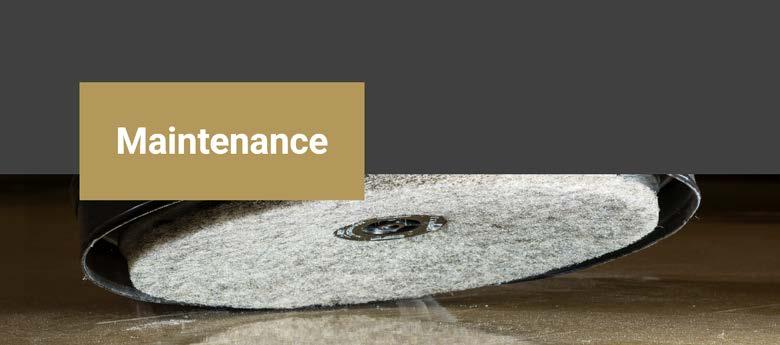
4 minute read
A guide to the how to of floor pads
Before floor pads became the norm for floor maintenance, every floor machine was supplied with a brush and was designed to use only brushes. With the advent of floor pads, the benefits of floor pads over brushes were apparent and the result has been that floor pads have all but replaced brushes as the accessory of choice.
The shortcomings of brushes can be summarised as, firstly, being limited to two of the four functions necessary to maintain a floor. Brushes can polish and can scrub. They do not spray-buff or strip effectively nor have the flexibility of choice of floor pads. Secondly, brushes depend on the tips of the bristles for their effectiveness. As soon as the weight of the machine together with the unidirection of turn causes the bristles to lay on their sides, the brush loses its effectiveness. And so, the cleaning industry has turned, to a very large extent, to the use of floor pads, according to Errol Goldberg, Sales Manager, ACS Cleaning Products.
It is interesting, however, that, despite floor pads being available and in use for over forty years, there are still anomalies in their use. There are some rules that do apply, and which should be adhered to for best results.
• Floor pads should always be washed as soon as possible after being used. The sooner washing through is effected, the easier it is to remove the combination of dirt and polish that adheres to the pad during use. Leaving the pad until the next morning before washing is not recommended. Even during use, invariably, if large areas are being maintained, a pad will load up. It then needs to be turned, and the other side used until it, too, is loaded up. Then the pad should be removed, sealed in a garbage bag to slow down drying out, and a second pad placed on the machine.
• The floor pad should never be left under the machine in storage. The weight of the machine resting (unevenly) on the pad causes uneven flattening of the pad. The result is that when taken out of storage and re-used the machine will tend to ride unevenly. This is most noticeable with an Ultra High-Speed machine where the pad distortion is magnified by the faster speed and can cause uncontrollable bucking of the machine.
• Choice of floor pads should never be based on price alone. There can be considerable differences in the productivity (sq. area maintained through the pad’s life) of pads from different manufacturers. The pad purchase decision should be based on a combination of life and cost as well as, of course, certainty of consistent results throughout the entire life of the pad.
Before floor pads became the norm for floor maintenance, every floor machine was supplied with a brush and was designed to use only brushes. With the advent of floor pads, the benefits of floor pads over brushes were apparent and the result has been that floor pads have all but replaced brushes as the accessory of choice.
• The correct size should always be used. An oversized pad can be destroyed by the overhang hitting obstacles and tearing. An undersized pad drops productivity considerably. For instance, using a 500mm pad where a 550mm is called for results in the job taking 9 percent longer. That adds 9 percent to labour and overhead costs. Using a 350mm pad on a 400mm machine loses an incredible 36 percent in productivity.
• Use the least aggressive pad that will do the job. This does not mean that a more aggressive floor pad cannot be used to do a job more quickly but in such a case a highly skilled, well-trained machine operator who understands the consequences of using a more aggressive pad, should be employed. For instance, the function of cutting back at Regular Speed (up to approximately 750rpm) is generally done with either a green scrub or a blue cleaner, the blue being less aggressive than the green
and therefore liable to remove less polish in the process. This has made the blue pad considerably more popular than the green and confirms the original principle of the least aggressive pad that will do the job. However, a skilled operator can use a brown dry stripping pad, which is even more aggressive than the green, to cut back and will get the job done in considerably less time. But with a less than greatly skilled and experienced operator, so much polish would be removed that the cutting back would almost translate into stripping.
Of course, there are other factors that determine whether the best value is obtained from a floor pad but just taking these rules into consideration can mean a substantial saving in the cost of the floor pads over a job.









